Futurama is likely my favorite show of all time. It resonates with me in a way very little has. It’s funny, smart, and it’s filled with charm and imagination far beyond its years. I’ve watched and read just about everything I could get my hands on to help me understand episodes of the series even better. I don’t consider myself a superfan, but the toys and cast autographs I have around my workspace combined with my nonstop references to friends may infer otherwise. “Meanwhile,” Futurama‘s final series finale (out of four), is a perfectly bittersweet episode that encompasses every single unforgettable aspect of the show in the most amazing ways. Not doting in the past for too long, but long enough to say thank you to fans, allowing them to gaze upon the myriad characters and wonderful world-building the show did in its 10-season run.
First coming to an end in August of 2003, Futurama spent most of its fifth season being jostled around by Fox network executives who clearly had no interest in what viewers wanted or even understood how consumers might make plans to navigate their time slots. Fox would shift shows like Futurama recklessly into new timeslots, sometimes even switching schedules without warning just days before a show was supposed to air. Those were dark times. When Comedy Central picked the show back up for another five seasons (one being the direct-to-DVD movie season), I was so excited to go on further adventures with the amazing crew of the Planet Express Delivery Company.
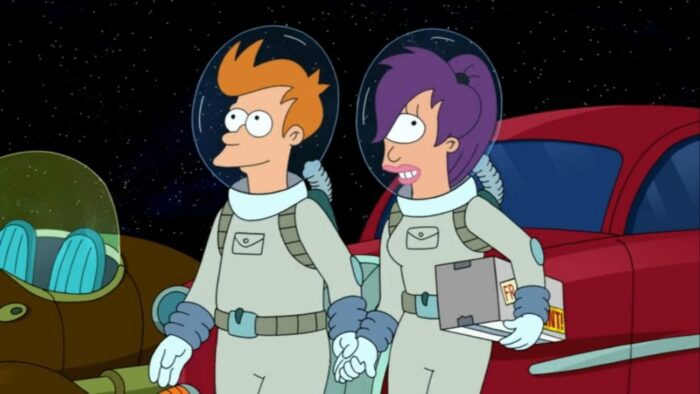
“Meanwhile” is really a love letter to Futurama’s fans. The episode sets up its premise through a humorous, lighthearted science fiction concept in the first half before incorporating the heartstring-tugging moments the series repeatedly hit fans with as it shaped a happily ever after for Fry and Leela. The cast and crew audio commentary on the episode talks about how the story of “Meanwhile” was originally born out of two separate concepts by the showrunners. Matt Groening had an early idea about a rewind button that allowed Fry to ask Leela out 50 times and failing the first 49 that he never quite got to fit correctly. David X. Cohen and Josh Weinstein were having a similar issue creating a time-traveling episode that found the characters traveling into a frozen timeline. Combining the two concepts, “Meanwhile” was born.
As Bender, Fry, and Leela make their way off of the ship and into the parking lot of their final delivery, an overwhelming feeling of melancholy persisted during my first viewing and, to this day, partially still exists. I get this way when shows I love come to an end. Admittedly, I still have a hard time getting through “Jurassic Bark” and “Game of Tones,” but when “Meanwhile” catches me at just the right time—and usually it’s when Fry asks, “So what do you say, wanna go around again?”—it also has an achingly beautiful effect. I have a hard time watching finales of some shows because I get overly emotional knowing I’ll never see the characters again. The multiple ways that show writers can finish particular arcs can have a lasting effect on whether or not I’ll ever revisit it. On my first viewing of “Meanwhile,” the idea that this would be the last time I’d ever see a new Futurama adventure was heart-wrenching while simultaneously exciting. Now I’ve seen the episode so many times I’ve lost count. Rewatching the show continuously, I, too, am caught in an infinite loop.
The final episode begins where the Planet Express crew delivered their very first package: Luna Park on the Moon. Luna Park is named for the Coney Island amusement park of the same name that opened in 1903. The then star attraction, “A Trip to the Moon,” shared the same name as a Georges Méliès short film. As a reference, we have the park’s Craterface mascot returning to the show only to have Bender symbolically put beer bottles in his eyes. A Trip to the Moon, as well as the literature that the film is based on—Jules Verne’s From the Earth to the Moon and H.G. Wells’s The First Men in the Moon—have a lot to do with the series and the inspiration behind many of the episodes. Verne and Wells’s work pops up consistently in episodes over the course of the series, essentially providing the creativity of the 30th-century perspective through the reimagining of works that philosophized the future at the start of the 20th century. Even the name Futurama was taken from a General Motors video presentation from the 1939 World’s Fair that mostly references the industrial revolution, the expansion of interstates, and glorious open highways.
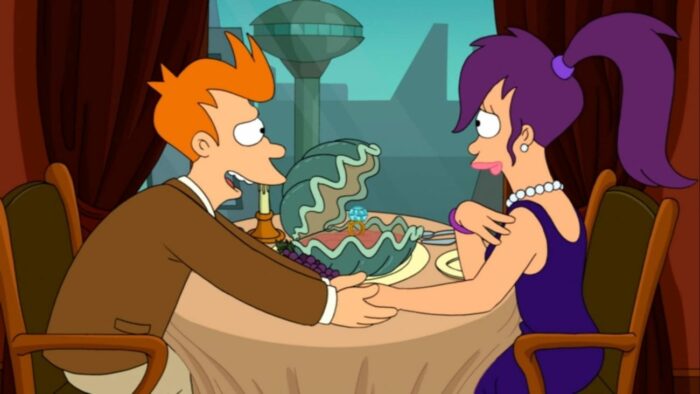
The crew takes in a day at the park after making the delivery, throwing a box at a full mailbox of other deliveries. Leela notes how the crew used to try a whole lot harder when they first started. The animation by Rough Draft studios is so phenomenally complex as Bender causes the Mecha-Hexadecapus ride to flail its arms emphatically, causing Leela to shoot out of the park’s domed roof and onto the unbreathable surface of the moon. Craterface plugs the breach in the dome—the second time we see a moon plug a hole in space (“Kif Gets Knocked Up a Notch” being the first— but Fry fears Leela is gone, and just as their relationship was finally turning into something special.
Something a lot of people don’t take into account is Fry’s growth as a character from the pre-movie seasons into the post-movie seasons. Lars, Fry’s alter-ego, has a lot to do with that. Lars was a version of Fry created as a timecode duplicate in “Bender’s Big Score” who was propelled back to the past and then froze himself to be with Leela in the future upon realizing Lars was the more mature version of Fry that Leela had been waiting for. When Fry and Leela find out about Lars’s identity after his death, Leela sees Fry for who he is, and Fry, I believe, tries harder to be a better companion to Leela. The office décor and cuisine Fry prepares in “Fry and Leela’s Big Fling” or the gestures he makes in “A Farewell to Arms” may not have the awe-inspiring effect of moving stars like in “Time Keeps on Slipping,” or writing Leela an opera in “The Devil’s Hands Are Idle Playthings.” Still, they are more practical early relationship efforts that speak to embracing a calmer atmosphere.
Leela’s return comes courtesy of her quick thinking, surviving on the lunar surface by stuffing herself inside a plush buggalo like Luke Skywalker inside a tauntaun and breathing the air from a life-size balloon version of herself that Fry bought for her in the park. This, of course, gets Fry thinking about how close he almost came to losing her and sets his thoughts on imminently proposing to Leela. I love the line Leela uses when he pops the question at Elzar’s: “This is so sudden after 13 years!” Though their relationship was anything other than traditional, especially when you consider the various on-and-off stages the couple traverse to make it to this point, my most hated being in “In-A-Gadda-Da-Leela” when a rogue satellite forced Fry to watch Leela and Zapp Brannigan go at it.
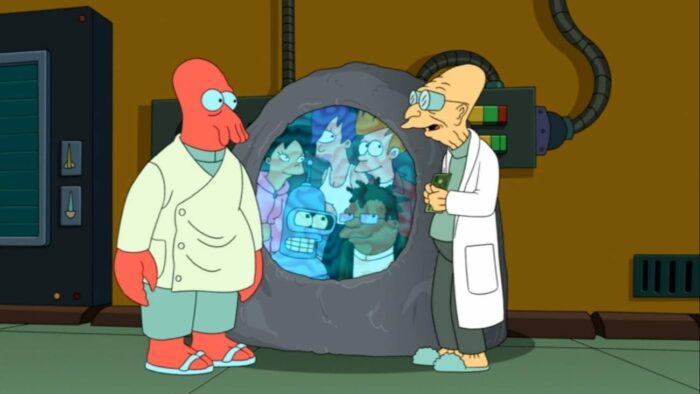
While Fry was busy mulling over how to make the perfect proposal to Leela, Professor Farnsworth went full Doc Brown on creating a time-travel device. The time button is slightly different from the standard time-travel devices we’ve grown accustomed to in film and TV. Unlike the H.G. Wells time machine, the likes of which inspired the Emmy-winning “The Late Phillip J. Fry,” the time button envelops its user in a time sphere and sends them back in time 10 seconds. Professor Farnsworth’s time button has since gone on to inspire the Emmy-winning “The Vat of Acid Episode” in Rick and Morty.
In the commentary, the Futurama cast and crew note how episode writer Ken Keeler provided a 10-page explanation in the script for how the time button operates. This is the kind of story-building and creative thinking that came to be expected from a writing staff that holds multiple PhDs, master’s degrees, and a cumulative half-century of learning from Harvard University. The production crew also notes that Keeler has regretted that Fry and Leela’s meeting at the top of the Vampire State Building took place at sunset and instead should’ve taken place at sunrise. Though, the crew goes on to debunk the mythos by stating, “It’s the future!” and that Bram Stoker suggests in Dracula that vampires could be out for a portion of the day. These are apparently the details very smart people argue about.
I have to admit that I was overly intrigued by the initial idea of the time shelter mentioned in the commentary. The device that allows people to exist outside of time and remember any effects incurred by the time button without having been in the bubble created by the button’s presser was initially going to be a time tunnel that the crew would build in 10-second increments as they attempted to rescue Fry. Being that he was continuously pressing the button across town after jumping from the Vampire State Building, this would have taken the crew weeks to build out of “time mud” and could have been an interesting concept to show how long Fry fell from the building and how annoyed the time tunnels occupants might have been. Imagine Hermes’s irritation with Zoidberg after weeks of tunneling across town?
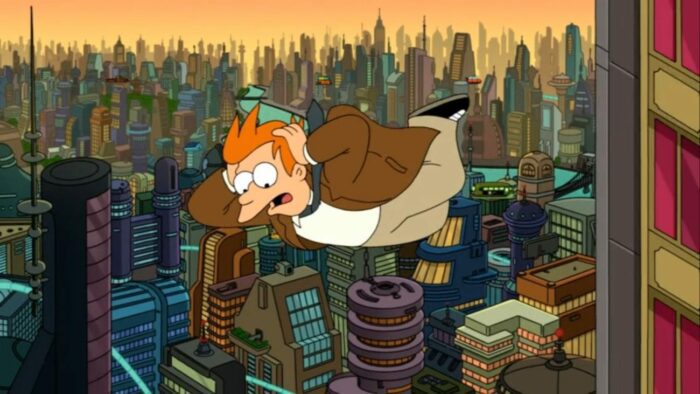
With as many times as we witness Fry fall to his death in the episode, it occurs to me that maybe there’s room to believe that maybe Fry is currently dead. Everything that occurs after he dies can be the fairy-tale version of An Occurrence at Owl Creek Bridge. It may anger people that I even think that, but I have considered it. That could also serve as another way the story could continue if Fry gets thrown into the stem cell bath that brought the crew back from their deaths in “Rebirth.” Still, I tend not to think like that because of how caring the next half of the episode is.
When Fry breaks the button after being rescued, we see the world go red and the time bubble Fry and Leela get stuck in is blue, reminding fans of a similar time-based escapade the crew had in the Emmy-winning “Roswell that Ends Well” where putting metal in the microwave caused a similar chroniton blast during a supernova explosion. I often wonder if Fry tasted blue this time.
The rest of the episode lies in Where’s Waldo? moments in the animation as the immense character catalog of favorites are placed in the frozen timeline. At the same time, Fry and Leela plan their life together. The two get all their friends together to watch them get married, and Leela breaks Scruffy’s spine for a second time (the final season’s premiere, “2-D Blacktop,” was the first). I love how these two make the most of their time together while still occasionally involving the other characters, like turning them into a rope swing while enjoying each other’s company.
It didn’t dawn on me right away that the whole episode is full of little time loops that ultimately bleed over into Fry’s infinite loop after jumping off of the Vampire State Building. In essence, the whole episode is one chain reaction that leads to the next before ultimately ending with the series becoming a part of the loop Fry imposed upon it. It’s brilliant. Though sometimes I lament for my favorite delivery boy and starship captain, they do lead beautiful lives with each other before reentering the timestream and causing the series to begin once again on Dec 31, 1999, only to go around again forever.
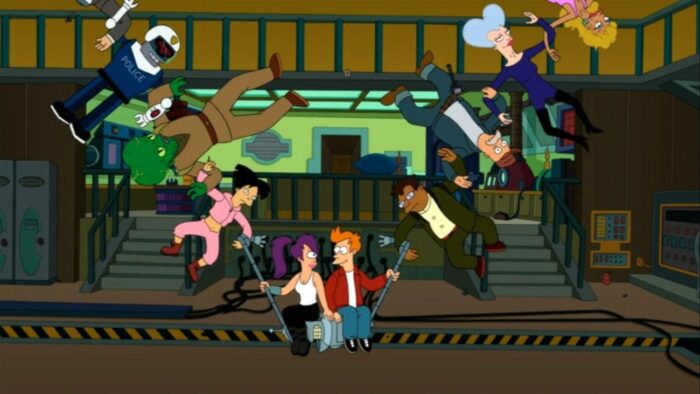
I do take part in a few fan pages on social media, which is part of the reason I decided to write this article about how much love I genuinely have for this finale. Seeing fan-inspired artwork of the life Fry and Leela could have in a post-loop world with children is an exciting concept, but I think people don’t see the loopholes the show set up for itself in the event it ever decided to come back again. When Professor Farnsworth comes back in his orthogonal time tubes, he tells Fry and Leela that after he hits the time button, a huge antichroniton blast will rip them out of stasis at the moment he conceived of the time button. Because the creators, in a genius move, asked Comedy Central to play the pilot episode again after the finale concluded, it created an on-brand infinite loop for the series.
Whispers and rumors of Futurama‘s return spring up from time to time. In August of last year, John DiMaggio told Chesirae Barbano of ScreenRant that he was open to the idea of a cast reunion in the form of a podcast, Radiorama, or something like that. This may have got the ball rolling for the rest of the cast to speak out because, in November, Maurice LaMarche (Calculon, Kif, Hedonism bot) floated the idea of new episodes to Syfy Wire’s Josh Weiss, suggesting that the cast is just waiting for a call from Fox to pick back up where they left off. However, the debate among fans is that “Meanwhile” is a pretty perfect ending befitting their favorite series, with people hoping that it stays that way.
I admit, I love the finale, but I’ll take new episodes any day. Ken Keeler is the credited writer of all four series finales, and most of them were rather good. “Overclockwise” is my least favorite, but I think Keeler probably has another two or three in him. The question is: how does Futurama come back if it’s stuck in an endless loop? I’ve been thinking about this, and I have some big theories that hopefully blow your mind. The blandest way to enter Season 11 would be to act like nothing ever happened. The time button ripped the crew out of the stasis, setting “Meanwhile” and any other episodes it chooses in a parallel timeline and dismisses them entirely. This is the laziest and most spiteful thing I think the writers could do to the fans. Even Sal would say, “don’t gets me starteds!”
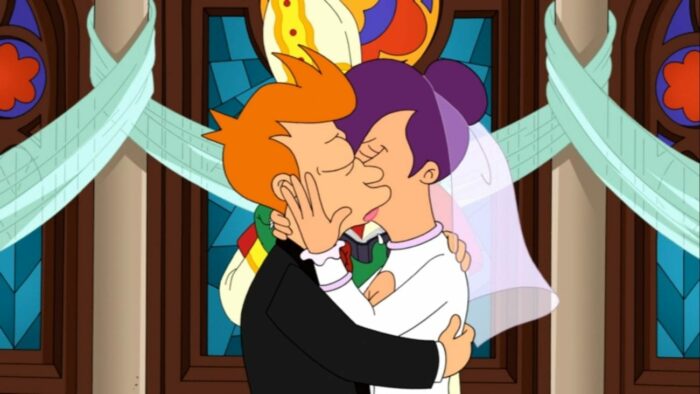
The next thing I considered was Bender’s timecode from “Bender’s Big Score.” The timecode is wiped when Bender loses the obedience virus. However, Bender still has to go back and put the tattoo on Fry at the end of the episode. Ergo, he still has the timecode. Plus, there’s also a reference to it in “Decision 3012” when Senator Travers talks about how he came to the past to win the election. Bender could use the timecode to save Fry before jumping off the Vampire State Building in the first place or insert himself in their timestream after the button is pressed, which, by Bender’s standards, would make the episode better because it includes robots.
My favorite idea involves Professor Farnsworth’s glimmer. Farnsworth confesses he had been “tunneling for decades, searching every instant from yesterday to tomorrow” before finding Fry and Leela at the top of the Vampire State Building. If somehow the crew realized they were caught in a loop, the three of them could use the tunnel to travel between yesterday and tomorrow. The time tunnel would still bring Fry and Leela back much older, but they could exit the tunnel back to their younger selves through the magic of cartoons. Even better, though, Fry and Leela could return to the spa with the age-reducing tar the crew once brought the professor in “Teenage Mutant Leela’s Hurdles” or take a trip through bits of their old adventures for an episode that could rectify some plot holes, like the resurrection of Roberto in “Stench and Stenchability” after dying, being resurrected as mecha-Roberto, and then killed again in “The Six Million Dollar Mon.”
Building off of the last concept, my final idea is that Futurama could return with lost episodes. This would appease fans who love the ending while simultaneously cleaning up some of the plot holes by offering new adventures in the background between other adventures with those missing pieces. Don’t get me wrong, I know it’s just a cartoon. Still, I have seen people go wild over details in those aforementioned social media groups, and that could be the best way to provide some fan service through an otherwise lackluster concept.
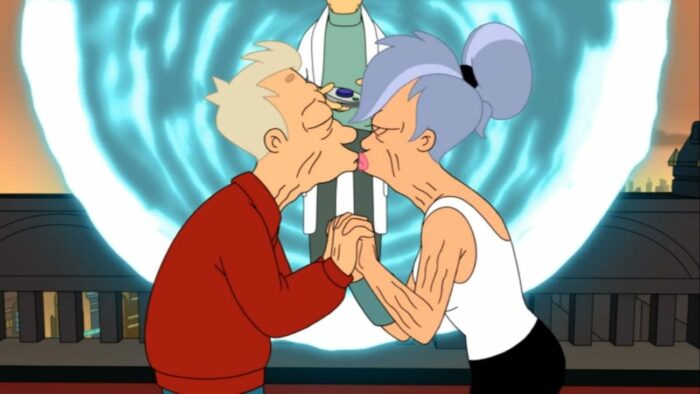
Though I am enjoying Disenchantment, which uses many of the same writers, producers, and voice actors from Futurama, it doesn’t resonate in the same way. I love the easter eggs the writers and animators throw in on occasion as well, suggesting that both Disenchantment and Futurama could be tied together somehow. I suppose there’s also Rick and Morty and the similar Solar Opposites that, at times, fill the void left by Futurama, but neither ever hit in quite the same way, being slightly more brash and extreme. No show could ever replace Futurama for me, but the closest I have found to a show with the same vibe is in Olan Rodgers’s Final Space. The incredible efforts put forth by the cast and crew of Final Space create the same energy of being extremely hilarious one minute before reducing you to tears the next.
It has been nearly eight years since Futurama aired “Meanwhile,” making it the longest the series has gone without a new episode. If the show never finds its way back to the airwaves, I’m sure I’ll be okay. Futurama is excellent as it currently exists, and that is largely thanks to the show’s never-ending loop that makes “Meanwhile” a programmer’s goto10 line, allowing it to continue forever.

